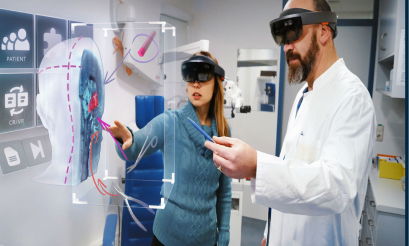
All of us understand AR and VR in the context of entertainment but many of us can understand the absolute impact these can have in our daily lives.
Consumers and Business interests in the opportunities presented by augmented reality (AR) and virtual reality (VR) have flourished over the past few months. The reason is the technology that has advanced enough to take exotic, expensive products, and turn them into everyday experiences. People are excited by what might unfold from such advancements. It is a gradual process driven by a few well-known, diverse developments that are put together to create practical interactions within AR and VR. Since, AR and VR have been held back because of the poor hardware and software, and the high cost. Hardware is often too large and too expensive for mass adoption, Software wasn’t effectively processing and interpreting data reliably, and the supply chain and applications necessary to produce components for AR and VR cost-effectively for a mass-market were just not available.
Why is it Important being Patient-centric in healthcare?
However, there hasn’t been the best time for both of these industries. VR has captured the imagination of video game followers, thanks to the HTC Vive and Oculus Rift. Filmmakers have shown interest in the field with some success; for instance, the VR short film, ’Henry,’ won an Emmy award. Further, interest in AR gaming and applications after Nintendo and Niantic’s surprise hit, Pokémon Go, and after Microsoft introduced its AR headset, the Microsoft HoloLens, too much demonstration.
Building up of capabilities in rapidly growing smaller hardware, with the rising progress of the software. Another factor for the expected success of AR and VR is the concurrence of another technological innovation, the smartphone.
AR and VR both owe to the smartphone. The rapid miniaturization of processors and sensors, with the establishment of standards, already accounts for most of what AR and VR require to succeed. They have the supply chains, user base, software expertise, and proven use cases for the technology at home as well as at work. All that remains is to put the pieces together in the hands of both consumers and enterprises. The latest development in smartphone technology: dual cameras. The dual-camera setup is a necessity for AR because it permits depth measurement, which is essential for a great AR experience. A fact that Apple’s phone, the iPhone 7 Plus, features dual cameras is extraordinary, this is also how Apple achieves the prized ‘bokeh’ effect it is marketing in its new phones. Additionally, Apple’s smart use of AI also helps to address known shortcomings. We don’t know yet if Apple plans to use dual cameras for AR. But, Cupertino giant’s intentions on one thing remains true — dual cameras are here to stay for the foreseeable future because Apple has long set the standard for what’s expected of a modern smartphone. For AR and VR, the more standardized this feature becomes, the more capable the AR and VR software ecosystem will become.
The confluence of these factors (rapid miniaturization and rapid standardization), the cost of producing and buying AR- and VR-ready headsets should fall to a reasonable price point that will appeal to both enterprises and consumers. We may not even see an immediate flash of AR and VR devices on the market, but a gradual build-up to AR and VR capabilities through smartphones and similar mobile devices.
The infinite possibilities:
The broad preference of AR and VR, and their respective software ecosystems, has massive enhancements for not just the tech sector, but nearly every other industry. Manufacturing, travel, education, and medical industries are some obvious examples. These industries are already pursuing and experimenting with AR and VR technologies.
What’s even more exciting is the varied, potential applications of AR and VR outside of common workplace environments. Farmers could use the data collected from drones to get a birds-eye view of their crop’s health in VR and point areas of concern. The fact that consumers and the general public may no longer have to depend on specialists for improvements, could spur a boom in AR and VR guides, software development, and entertainment. The possibilities are truly limitless. AR and VR are capturing people’s attention now because they have the potential to transform how we work and play tomorrow. Thankfully, the gradual progress of technology is turning this dream into a reality.